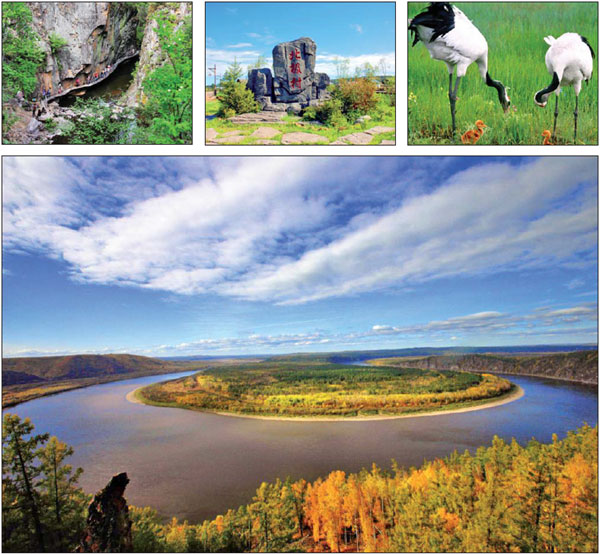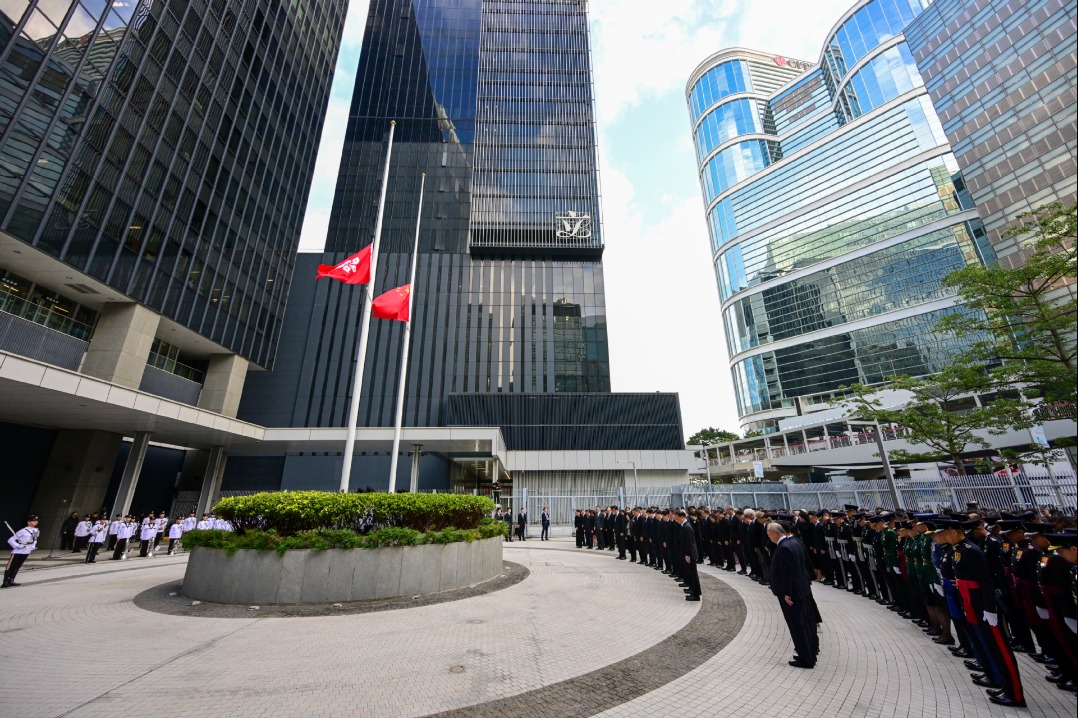Cool runnings

Sweltering weather coaxes tourists to cool destinations like Heilongjiang
Xiang Shuangshuang believes China's northernmost province, Heilongjiang, is a cool place to beat the heat of Beijing's hottest months. In every sense.
Her upcoming trip will be time spent in greener pastures. In every sense.
| Clockwise from top left: Jiayin Dinosaurs Geological Park. Beiji village, China's northernmost point. Cranes with their chicks at Zhalong Nature Preserve. A turn of the Heilong River, known as the First Turn of the Longjiang River, in the Greater Hinggan Mountains area. Photos provided to China Daily |
"I look forward to exploring verdant forests and wetlands," she says. "But the main reason I'm going is the cooler weather."
Xiang enjoyed her 2009 visit as a university student. She's hoping for a sense of deja vu. "It was a cool place to hike. You need a quilt at night," she says, adding that Harbin's architecture, Wudalianchi's hot springs and Yichun's woodlands also left a deep impression.
Heilongjiang is typically touted as a winter wonderland, and deservingly so. But it also offers special summer sojourns. Weather is the boon in both cases.
The provincial capital, Harbin, took the top spot in a 2014 report on domestic summer destinations jointly released by the China Meteorological Administration and the China Tourism Academy. The average temperature in summer is 20 C. Consequently, the province announced five suggested summer tours in May. They feature volcanoes, wetlands, China's eastern and northernmost points, forests and urban fun.
"Visitors can configure these routes according to preference," says Xi Dongguang, director of Heilongjiang's tourism authority. Kang Guoming, chairman of China CYTS Tours, adds that his company will also focus on ecotourism to develop products such as resorts, leisure, health and family fun.
Three special routes have been designed for the elderly, and daytrips are daydreams that developers hope will come true. The provincial government has teamed up with major online travel brands to cultivate itineraries that take travelers out but bring them back by bedtime.
Heilongjiang's easternmost route integrates wetlands and the culture they saturate, Fuyuan's museum showcases the province's history, and visitors can experience the Russian influence of its border culture, Xi says.
Forests cover 220,000 square kilometers, which is roughly equivalent to the size of the Korean Peninsula, while wetlands cover 55,000 sq km, roughly to the size of Croatia.
Mohe county's Beiji village is the only place in China where visitors can see aurora borealis.
Yaoquan town's Wudalianchi nature reserve contains 14 volcanoes and five lakes, and it won the Michel Batisse Award at the fourth World Congress of Biosphere Reserves in Lima, Peru, in March.
Mudanjiang city's Jingpo Lake is the world's second-biggest volcanic barrier lake, after Switzerland's Lake Geneva. The 300-meter-wide Diaoshuilou Waterfall that crashes 20 meters into Jingpo Lake is also the world's biggest basalt cascade.
Harbin's music and wetland festivals, Yichun's international forest ecology tourism festival, and Mohe's aurora borealis festival will be staged this summer.
Dozens of marathons and hiking events are also planned, Xi says. Road trips from Fuyuan to Mohe will be organized along the Chinese-Russian border by the province and Jeep, which runs one of China's biggest cross-country driving clubs.
"Heilongjiang is an amazing place to drive," Xi says. "We have vast landscapes. You can drive a while without seeing another car."
Tourism has surged since Heilongjiang initiated summertime itineraries last year. Roughly 80 million people visited scenic spots in summer last year, 21 percent more than in 2014. Xi says a 15 percent increase is expected this year.
The provincial rail administration opened a new tourism line from Harbin to Heihe in May. The longest railway line in China connects the province's Qiqihar to Urumqi, capital of northwestern China's Xinjiang Uygur autonomous region. It crosses eight provinces and the city of Tianjin.
A high-speed railway also connects Harbin to Liaoning province's capital, Shenyang, and Jilin province's capital, Changchun. Eleven airports link Heilongjiang to major cities across the country, as well as Russia, South Korea and the United States. New airports at Suifenhe, Wudalianchi and Jiansanjiang will start operating soon.
This will open up lesser-known yet worthwhile sites like Jiansanjiang, an agritourism destination.
Xiang, for one, plans to drive around the Greater Hinggan Mountains. "I want to explore and shoot photos deep in the forest, and bring home some special food found on the mountainside," she says, adding that she hopes to also hop aboard a hot-air balloon to float over the Nanwang River.
That really would be cool.
yangfeiyue@chinadaily.com.cn
New seasonal itineraries
Heihe-Qiqihar-Daqing
Visitors can explore unique volcanoes and wetlands at Wudalianchi and Zhalong Nature Preserve, and enjoy health and fitness experiences in Daqing's hot springs. The area's Russian culture can be experienced at the Heihe-Blagoveshchensk border.
Visitors can travel to China's easternmost point,Heixiazi Island,and Wusu town. Khabarovsk also features Russian culture, and Hulin has Hutou Fort.
A museum in Mishan chronicles the development of the northern region's wilderness. Jiamusi shows modern agriculture alongside ancient fishing and hunting culture. Mudanjiang has Jingpo Lake and crater forests.
Yichun Visitors can hike Tangwanghe, the nation's first approved national park, and China's biggest and best-preserved primitive Korean pine forest. The Jiayin Dinosaurs Geological Park is where the country's first dinosaur fossil was found.
Mohe
Visitors can travel to Beiji village, China's northernmost point, and savor Songyuan's primitive woodlands. The aurora borealis and polar daytime phenomena are highlights.
Harbin music and beer carnivals offer a chance to party. Visitors can see the Manchurian tiger breeding facility and enjoy Russian performances and food at Volga Manor.
| The Russian-style St. Sophia Cathedral in Harbin. Provided to China Daily |
(China Daily European Weekly 06/24/2016 page19)
Today's Top News
- Takaichi must stop rubbing salt in wounds, retract Taiwan remarks
- Millions vie for civil service jobs
- Chinese landmark trade corridor handles over 5m TEUs
- China holds first national civil service exam since raising eligibility age cap
- Xi's article on CPC self-reform to be published
- Xi stresses improving long-term mechanisms for cyberspace governance
































